|
Report from
Europe
EU27 tropical wood imports still
high but beginning to
slow
After reaching the highest level for nearly a decade in the
first half of this year, the US$ value of EU27 imports of
wood and wood furniture products from tropical countries
declined sharply in July and August. However, import
value during the summer months was still higher than is
usual at that time of year (Chart 1).

While the value of EU27 imports from the tropics has
strongly rebounded this year, imports from other parts of
the world have risen at an even faster pace so that the
decline in market share for tropical countries has
continued (Chart 2).

The extraordinary market conditions that have emerged
during the COVID-19 pandemic have driven total EU27
imports of wood and wood furniture products from all
non-EU countries this year close to the record levels of
2007 and 2008, just prior to the global financial crises.
Total EU27 import value of wood and wood furniture in
the first eight months of this year was US$13.53 billion,
40% more than in the same period in 2020. Import value
of tropical products was US$2.46 billion, 24% more than
the same period in 2020. However import value from nontropical
regions was US$11.08 billion, a 44% increase.
Imports were up by 39% from China to US$3.44 billion,
by 65% from Russia to US$2.15 billion, by 76% from
Belarus to US$1.16 billion, and by 57% from Ukraine to
US$1.11 billion.
The 40% increase in EU27 import value from the tropics
this year is not mirrored by an equivalent increase in
import quantity. In quantity terms, imports from tropical
countries in the first eight months were 1.17 million
tonnes this year, only 7% more than in 2020 and still 9%
down compared to 2019.
A large part of the gain in import value of tropical
products is due to a significant rise in prices. Freight rates
have been at unprecedented levels this year.
The Drewry World Container Index indicates that global
rates for a 40 foot container peaked at over US$10000
dollars in the middle of September this year compared to
US$2000 in the same month in 2020.
FOB prices for tropical wood products have also been
driven up this year in response to the sharp increase in
global demand at a time when supplies are scarce and
tropical producers continue to operate under extremely
challenging conditions during the pandemic. This in turn
has led to EU27 importers buying more from more
accessible suppliers in the European neighbourhood and a
continued loss of market share for tropical suppliers in the
EU market.
Highest tropical import value into the EU27 since 2012
The increase in the value of EU27 imports from tropical
countries this year is heavily concentrated on wood
furniture products. Although import value of most other
wood products from tropical countries has made up some
of the ground lost in 2020, it is still below the level
prevailing before the COVID pandemic in 2019 (Chart 3).
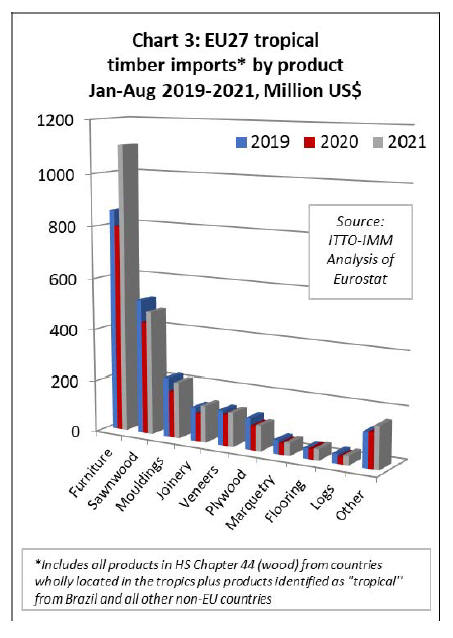
In the first eight months this year, import value into all the
largest EU27 destinations for tropical wood and wood
furniture products was significantly higher than in the
same period in 2020. Furthermore, of the largest markets,
only in Italy was import value in the first eight months of
this year less than in the same period in 2019 before the
pandemic (Chart 4).
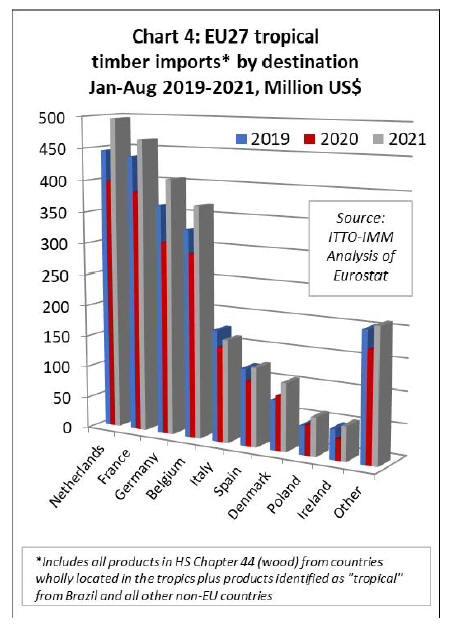
EU recovery expected to continue but significant
downside risks are emerging
Longer term market prospects in the EU27 look
reasonable as the economic expansion in the region is
expected to continue, although there are significant
downside risks emerging, according to the EU Autumn
2021 Economic Forecast published on 11 November.
According to the Forecast, the EU economy is set to grow
by 5% this year and to keep a solid pace of growth of
4.3% next year before easing to 2.5% in 2023. A strong
rebound in the second and third quarters of this year lifted
the EU economy back to around its level of the last quarter
of 2019. This happened one quarter earlier than the EU
expected in the Spring Forecast issued in May.
Disruptions in global logistics and shortages of several
raw and intermediate inputs have been increasingly
weighing on activity in the EU this year. Manufacturing,
in particular, is being held back by production input
shortages, delays in input delivery and increased strains on
available production capacity. Surging energy prices, most
notably for natural gas and electricity, are also expected to
dampen the growth momentum in the short term.
Still, strong domestic demand is expected to continue
fuelling the economic expansion in the EU. The
Commission's October business surveys indicate that
economic sentiment increased slightly in all main sectors
except construction.
An improving labour market, falling household saving
rates, favourable financing conditions and full deployment
of the "Recovery and Resilience Facility" (RFF), are
expected to drive the economic expansion and fuel
domestic consumption. Foreign demand is also expected
to be supportive of growth.
The global economy is expected to strongly rebound this
year and to continue expanding in the next two years,
albeit at a more moderate pace and with quite divergent
paths.
The RFF is the EU €723.8 billion stimulus package -
comprising €385.8 billion in loans and €338 billion in
grants ¨C in support of Member State Covid recovery
measures which extends until 2026, with two thirds of the
money expected to be allocated before the end of 2023.
Model simulations conducted by the Commission indicate
the package could increase EU GDP by up to 1.5% during
its years of active operation. RFF support measures are
particularly targeted at southern and eastern Member
States and at green investments to help achieve the EU
2050 net zero carbon commitment.
According to the EU Forecast, while the RFF is being
rolled out to support the most indebted Member States,
many governments have started to phase out emergency
support measures at national level and budget deficits are
being reduced. Employment levels are also expected to
increase above pre-pandemic levels and the
unemployment rate should decrease to 6.5% in 2023.
The Forecast suggests that strong demand following the
re-opening of economies, combined with supply
bottlenecks and higher energy prices, have contributed to
higher levels of inflation. This situation is expected to be
largely transitory. Inflation in the EU is expected to peak
at 2.6% this year before easing slightly to 2.5% next year
and 1.6% in 2023.
However, the Forecast also notes that uncertainty remains
substantial, and the risks to the outlook are tilted to the
downside. The recovery continues to be heavily dependent
on the evolution of the pandemic, both within and outside
the EU.
The improving health situation, which allowed the
economy to bounce back, is now being challenged by
rising infections across the EU. Since the beginning of
October, the 14-day average incidence of infections in the
EU has recorded the highest level since mid-May.
The strongest increases are reported in countries with
below EU-average vaccination rates. For now,
hospitalisations and deaths associated with COVID-19
infections remain low compared to previous waves. But
they are slowly rising, posing a risk to economic
prospects.
Economic conditions vary widely between Member States,
according to the EU Forecast. Germany's GDP rebounded
in the second and third quarters as the easing of
containment measures spurred spending on services.
However, supply bottlenecks are slowing down
manufacturing and putting a lid on the rebound of exports
and investment. So growth is projected at a modest 2.7%
this year and is set to reach 4.6% in 2022 before
moderating to 1.7% in 2023.
In France, economic activity is forecast to rebound by
6.5% in 2021, reaching its pre-crisis level by the end of
this year. The third quarter growth rate was particularly
strong thanks to largely eased restrictions. Growth is
expected to remain solid in 2022 and 2023 at 3.8% and
2.3% respectively.
For Italy, real GDP is projected to increase by 6.2% this
year. The economy rebounded strongly in the second and
third quarters thanks mainly to consumer services. Growth
is set to continue at a robust pace of 4.3% in 2022 thanks
to easing supply shortages and RRF-supported
investments and reforms. GDP is set to expand by 2.3% in
2023, a growth rate still sizeably above the long-term
average.
In Spain, growth is projected at 4.6% this year, below the
EU's Summer expectations. However, Spain's GDP is
expected to remain on a very strong growth path over the
next two years, also thanks to the implementation of the
RRF. Growth is projected at 5.5% in 2022 and at 4.4% in
2023.
In Poland the economy is expected to embark on a solid
expansion after a mild recession last year. GDP growth is
expected at 4.9% in 2021, 5.2% in 2022 and 4.4% in 2023.
EU construction sector still fragile
The fragile position of the construction sector in the EU, a
key driver of timber demand in the region, is revealed by
the IHS Markit Eurozone Construction Index. The index
increased from 49.5 in August to 50.0 in September and
then to 51.2 in October. The trend is positive but, with
50.0 being the dividing line between contraction and
growth, the index implies that sentiment in the sector is
very mixed.
Where construction activity rose, companies often cited
stronger demand growth, although this was offset by a
lack of raw materials which halted work on site.
Underlying data indicated that growth was centred around
house building, while commercial construction was steady
but infrastructure activity was still slow.
Overall the IHS Markit reports that construction firms are
still confident that activity will increase over the next 12
months amid forecasts of strengthening economic
conditions, improved supplier performance and new
projects.
Strong recovery in EU27 wood furniture imports from
tropical countries
In the first eight months of 2021, EU27 import value of
wood furniture from tropical countries was US$1.1 billion,
38% and 29% higher than the same period in 2020 and
2019 respectively. After a slow start to the year, the value
of EU27 wood furniture imports from the two largest
tropical suppliers ¨C Vietnam and Indonesia ¨C increased
sharply from the second quarter onwards. By the end of
the first eight months, import value was up 29% from
Vietnam to US$455 million and up 33% from Indonesia to
US$293 million.
Meanwhile EU27 imports of wood furniture from India
and Malaysia, which were very strong in the first half of
this year, slowed a little during the summer months. After
eight months this year, import value from India was
US$237 million, 78% greater than the same period in
2020, while import value from Malaysia was US$85
million, a gain of 42%. For all four leading tropical
suppliers, EU27 wood furniture import value in the first
eight months of 2021 was higher even than in 2019 before
the pandemic (Chart 5).
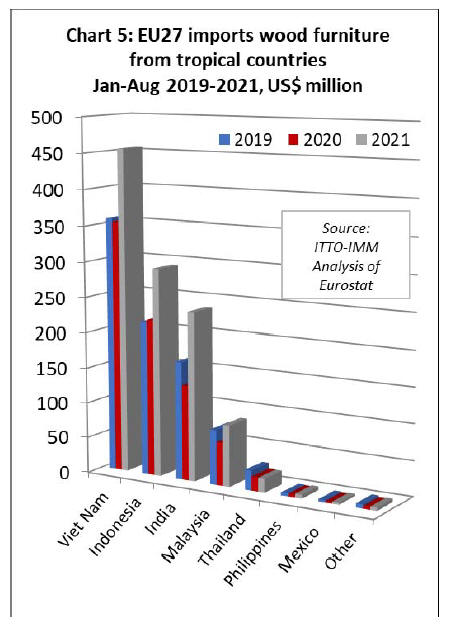
U27 imports of tropical sawnwood still below pre-
COVID level
In the first eight months of 2021, EU27 import value of
tropical sawnwood was US$475 million, up 10% on 2020
but down 8% on 2019. In quantity terms, imports of
554,000 cu.m in the first eight months were 7% higher
than the same period in 2020 but still down 11% compared
to the same period in 2019 before the pandemic.
Imports of 189,500 cu.m from Cameroon in the first eight
months this year were 4% higher than the same period in
2020 and still 13% down compared to 2019. Imports of
86,500 cu.m from Brazil were up 5% compared to 2020
but down 20% compared to 2019.
Sawnwood imports from Gabon and Congo fared better
during the first eight months of this year. Imports from
Gabon, at 89,000 cu.m, were up 31% on 2020 and up 10%
compared to 2019. For the Congo, imports were 42,500
cu.m in the eight month period, up 26% on 2020 and 6%
on 2019.
Imports of sawnwood from Côte d'Ivoire were 17,750
cu.m in the first eight months of this year, up 13%
compared to 2020 but down 25% on 2019.
The long term decline in EU27 imports of sawnwood from
Malaysia continued in the first eight months this year, at
51,500 cu.m 14% less than the same period in 2020 and
27% down on 2019 (Chart 6).
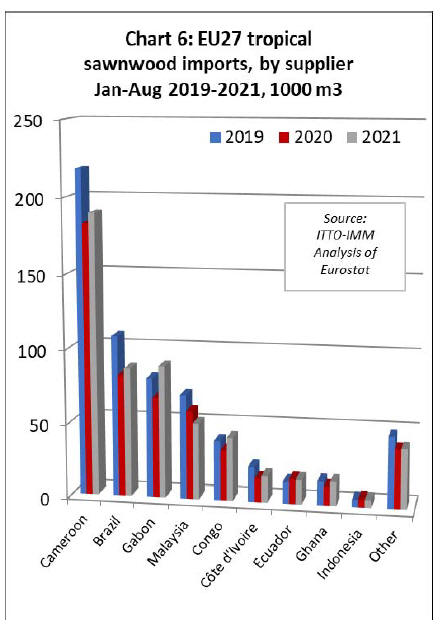
In the first eight months of 2021, EU27 import value of
tropical mouldings/decking was US$216 million, up 20%
on 2020 but down 5% on 2019. In quantity terms, tropical
mouldings/decking imports increased 11% to 128,500
tonnes in the first eight months of this year compared to
last.
However import quantity was still down 5% compared to
2019. Imports of 51,900 tonnes from the largest supplier
Brazil, were 3% down on the same period last year and
14% less than in 2019.
Despite widespread reports of supply shortages for
Indonesian bangkirai decking, imports of
mouldings/decking from Indonesia were 43,100 tonnes
during the first eight months of 2021, 21% more than the
same period in 2020 and 1% more than in 2019. Imports
of mouldings/decking from Peru were 10,000 tonnes, 54%
more than in 2020 and 28% up on 2019.
Sawnwood imports from Gabon were 5,900 tonnes in the
first eight months this year, 49% more than the same
period in 2020 and 13% more than in 2019. Imports from
Malaysia were 4,600 tonnes in the first eight months this
year, 10% less than in 2020 and 29% down compared to
2019. (Chart 7).
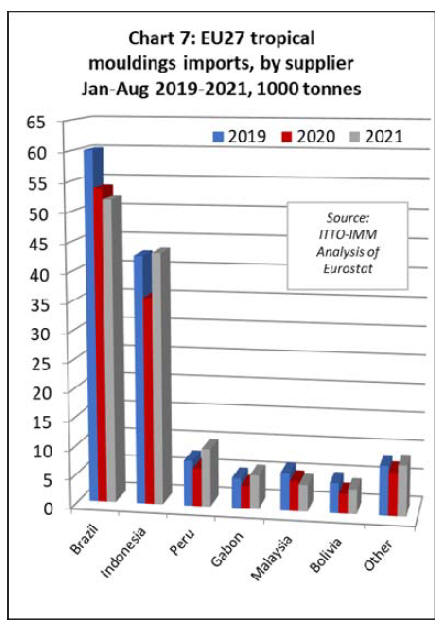
In the first eight months of 2021, EU27 import value of
tropical logs was US$36 million, 31% up on 2020 but still
3% less than 2019. In quantity terms, imports of 66,000
cu.m were 22% more than the same period in 2020 but
11% less than the same period in 2019. Imports of 29,400
cu.m from Congo, now by far the largest supplier of
tropical logs to the EU, were 38% more than the same
period in 2020 and 29% more than the same period in
2019.
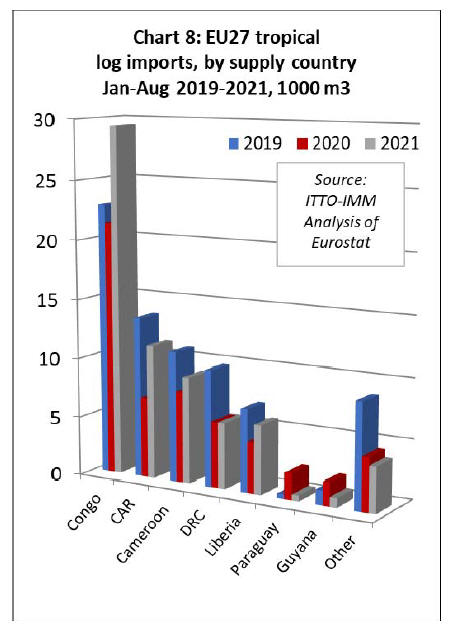
Imports in the first eight months this year from all other
leading supply countries - CAR (11,300 cu.m), Cameroon
(9,000 cu.m), DRC (5,600 cu.m), Liberia (5,800 cu.m) -
were all more than the same period in 2020 but still down
on the level of 2019 before the pandemic.
Gabon leads slow recovery in EU27 imports of tropical
veneer and plywood
In the first eight months of 2021, EU27 import value of
tropical veneer was US$131 million, 9% more than in
2020 but 2% less than 2019. In quantity terms, imports
were 192,900 cu.m in the first eight months of this year, a
gain of 2% compared to 2020 and 3% less than in 2019.
After a rapid rise last year, veneer imports from Gabon
were 102,800 cu.m in the first eight months this year,
down 3% compared to 2020 but still 23% more than in
2019. At 41,300 cu.m, veneer imports from Côte d'Ivoire
were 13% more than in 2020 but still down 16% compared
to 2019.
Imports of 17,800 cu.m from Cameroon were 3% more
than in 2020 but 35% less than in 2019. Veneer imports
from Congo were 11,700 cu.m in the first eight months
this year, 20% and 4% more than the same period in 2020
and 2019 respectively (Chart 9).
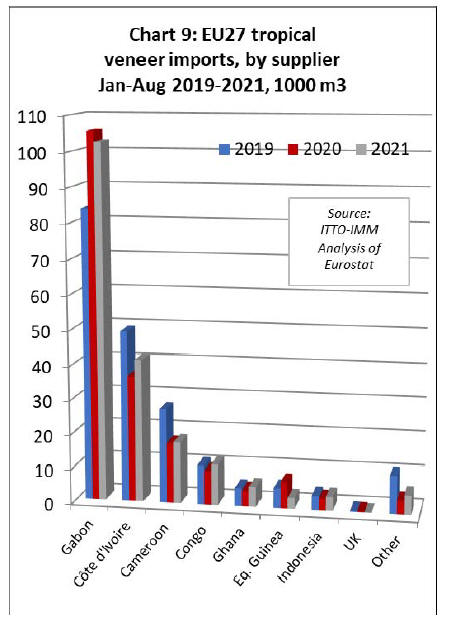
Overall the signs are that tropical hardwood plywood has
been a big loser in the competitive battle for dominance of
the EU plywood market, particularly against Russian birch
plywood. In the first eight months of 2021, EU27 import
value of tropical plywood was US$98 million, up 6%
compared to 2020 but down 18% on 2019. In volume
terms, imports of 135,500 cu.m in the first eight months
this year were 11% less than the same period in 2020 and
31% down compared to 2019.
EU27 plywood imports from Indonesia were 48,100 cu.m
in the first eight months this year, 3% less than the same
period in 2020 and 22% down compared to the same
period in 2019. Imports of tropical hardwood faced
plywood from China were 29,700 cu.m, 34% less than in
2020 and 49% down compared to 2019. EU27 imports of
tropical hardwood plywood from Vietnam and indirect
imports from the UK also continued to slide in the first
eight months of this year.
More positively, imports of tropical hardwood plywood
from Gabon and Morocco made more inroads into the
EU27 market in the first eight months of this year. Imports
from Gabon were 21,400 cu.m in the eight month period,
23% more than the same period in 2020 and 18% more
than in 2019. Imports from Morocco were 9,400 cu.m,
29% and 11% more than the same period in 2020 and
2019 respectively (Chart 10).
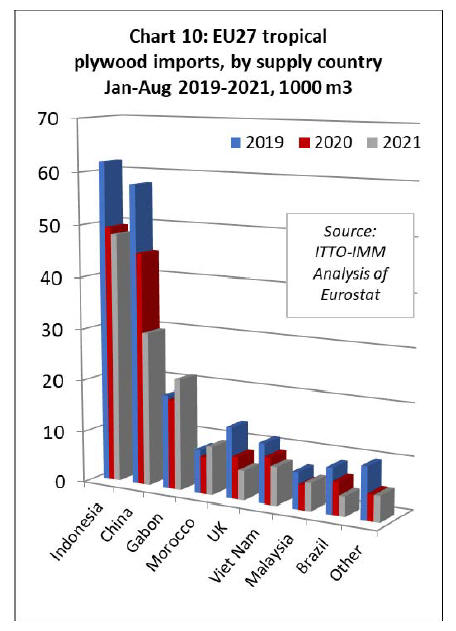
Rise in EU27 imports of tropical flooring from Malaysia
continues
In the first eight months of 2021, EU27 import value of
tropical flooring products was US$43 million, 7% higher
than the same period in both 2020 and 2019. However in
quantity terms, imports of 11,300 tonnes in the first eight
months this year were 5% down compared to 2020 and 3%
less than in 2019. The rise in EU27 wood flooring imports
from Malaysia, that began last year, has continued into
2021.
Imports of 6,850 tonnes from Malaysia in the first eight
months this year were 22% more than the same period in
2020 and 59% greater than in 2019. In contrast, flooring
imports from Indonesia of only 3,300 tonnes were 12%
less than in 2020 and 15% down compared to 2019.
Imports from Brazil have also continued to slide, at just
1,400 tonnes in the first eight months, 60% down
compared to both 2020 and 2019 (Chart 11).
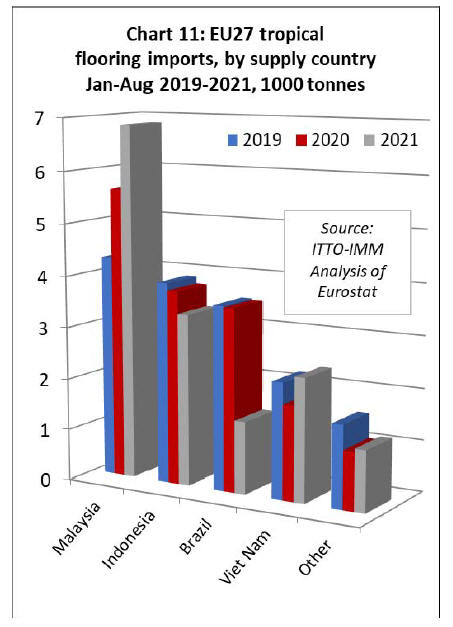
The value of EU27 imports of other joinery products from
tropical countries - which mainly comprise laminated
window scantlings, kitchen tops and wood doors -
increased 31% to US$141 million in the first eight months
of this year. Imports were up 32% to US$72 million from
Indonesia, up 15% to US$39 million from Malaysia, and
up 44% to US$15 million from Vietnam.
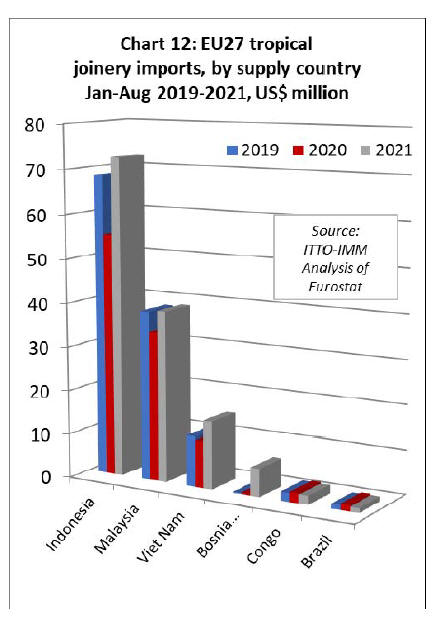
This year the EU27 has also begun to import joinery
products manufactured using tropical hardwood from
Bosnia. Import value from Bosnia was US$6.4 million in
the first eight months of 2021 (Chart 12).
Draft EU "global deforestation" law
The much anticipated proposal for an EU legal framework
to "halt and reverse EU-driven global deforestation" is due
to be published by the European Commission on 17
November. The proposal follows a European Parliament
decision of 22 October 2020 calling on the European
Commission to draft such a legal framework.
This decision was backed by a resolution on 9 June 2021
on the EU Biodiversity Strategy for 2030 in which the
Parliament asked the Commission to urgently present a
proposal for an EU legal framework based on mandatory
due diligence that ensures that value chains are sustainable
and that products or commodities placed on the EU market
do not result in or derive from deforestation, forest
degradation, ecosystem conversion or degradation or
human rights violations.
The implications of the new legal framework are
potentially far-reaching, particularly for the future of the
existing framework of FLEGT Voluntary Partnerships
Agreements, FLEGT licensing and the EU Timber
Regulation.
Early indications are that the EUTR may be rolled into this
broader regulation imposing due diligence requirements
on a range of "forest-risk" commodities. Furthermore the
FLEGT licenses - so far only issued for Indonesian timber
products exports to the EU - while accepted as evidence of
legality under the new law may not necessarily be
accepted as fulfilling the "deforestation free" criteria.
Also, the EU may not seek to extend FLEGT licensing
into any other country once the new regulation is in place.
The Commission proposal to be issued on 17th November
will be a draft of the new regulation most likely adopted
using the ordinary legislative procedure. It will be subject
to review and possible amendment by both the European
Parliament (directly elected) and the European Council
(representatives of the 27 EU countries). Both the
Parliament and European Council must agree on the legal
text and any amendments before the draft can become law.
Further details of the content and implications of the draft
legislation and of the legislative process will be provided
in the next market report once the official draft is
available.
|